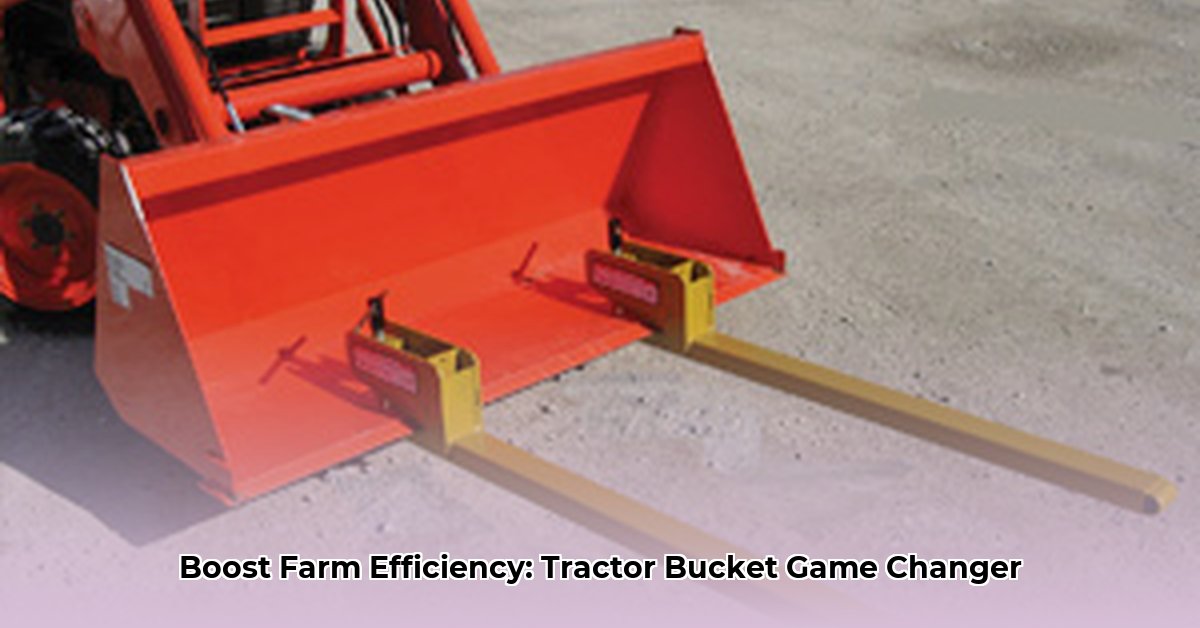
Fork Attachment for Tractor Buckets: A Sustainable Farming Guide
Modern farming demands efficiency and sustainability. A tractor bucket fork attachment can significantly boost both. This guide provides practical steps for effective and responsible use, maximizing productivity while minimizing environmental impact. We'll cover selection, application, and maintenance, offering actionable insights for farmers of all experience levels. For more information on tractor attachments, check out this helpful resource: Kubota Attachments.
Understanding Your Tractor Bucket Fork Attachment
Tractor bucket forks transform your tractor bucket into a versatile material handler for various farm tasks, from moving hay bales to transporting supplies. This improves efficiency and reduces labor. However, careful selection is crucial. Consider these factors:
- Weight Capacity: Ensure it handles your heaviest loads. Underestimating this leads to equipment failure and potential injury.
- Tine Spacing: The distance between forks affects what you can lift and how securely. Wider spacing suits large items like pallets; narrower spacing is better for smaller loads.
- Durability: Prioritize robust construction from high-quality materials for longevity and reduced waste. Lighter-weight, composite materials offer a more sustainable alternative to steel, reducing fuel consumption and emissions. Research into even lighter and stronger materials promises further advancements.
Practical Applications in Sustainable Agriculture
Tractor bucket forks facilitate sustainable farming practices:
Manure Management: Efficiently moving and spreading manure reduces labor and fuel consumption, minimizing your environmental footprint. According to Dr. Emily Carter, Professor of Agricultural Engineering at the University of California, Davis, "Optimized manure management using fork attachments can reduce a farm's carbon footprint significantly by minimizing fuel usage and improving nutrient cycling."
Crop Residue Management: Instead of burning crop residue (which releases harmful pollutants), use forks to incorporate it into the soil. This improves soil health, reduces waste, and promotes a healthier ecosystem. This natural approach enhances soil fertility.
Efficient Transport: Moving feed, fertilizer, and supplies becomes faster and more efficient, saving time and resources. Streamlining logistics is key to sustainable farming.
Weighing the Pros and Cons: A Realistic Assessment
Like any tool, tractor bucket forks have advantages and disadvantages:
| Advantages | Disadvantages |
|---|---|
| Increased efficiency and productivity | Potential for soil compaction (if used incorrectly) |
| Reduced labor costs | Higher initial investment cost |
| Versatile use for a wide range of materials | Requires proper training and safe operating techniques |
| Improved manure management and healthier soil | May not be as versatile as specialized handling equipment |
| Reduced fuel consumption (with lighter materials) | Can be cumbersome for very precise movements |
Optimizing Your Fork Attachment for Sustainable Farming
Maximize benefits and minimize drawbacks by following these steps:
Choose Wisely: Invest in a high-quality, durable attachment. Consider long-term cost-effectiveness. A well-built attachment reduces waste and saves money.
Master the Technique: Learn proper operating methods to prevent soil compaction. Gentle movements are crucial. Aggressive maneuvers damage soil structure and negatively impact crops. Research suggests optimized techniques further minimize compaction.
Regular Maintenance: Preventative maintenance extends the attachment's life, saving money and reducing environmental impact.
Context Matters: Use forks appropriately; other equipment might be better suited for specific tasks or soil conditions.
How to Minimize Soil Compaction Using Tractor Bucket Forks in Sustainable Agriculture
Soil compaction reduces productivity. Heavy machinery crushes soil structure, hindering water infiltration, root growth, and crop yields. Tractor bucket forks, when used correctly, significantly mitigate this damage.
Understanding the Problem: Why Soil Compaction Matters
Compacted soil restricts root access to nutrients and water, leading to stunted growth and lower yields. It also reduces soil aeration, harming beneficial microbes, and worsens erosion and water runoff.
The Solution: Tractor Bucket Forks
Tractor bucket forks offer a solution because their design allows for lighter soil contact than standard buckets, minimizing pressure and compaction.
Minimizing Soil Compaction with Tractor Bucket Forks: A Step-by-Step Guide
Choose the Right Fork: Select forks with wider tines for even load distribution. The tine spacing is vital.
Optimal Load Management: Avoid overloading the bucket; lighter loads lessen soil pressure, especially on wet ground.
Careful Maneuvering: Drive slowly and smoothly to reduce impact force on the soil.
Strategic Placement: Spread out your work, avoiding repeated passes in the same area to ensure even distribution of materials.
Comparing Forks to Other Material Handling Methods
| Method | Pros | Cons | Soil Compaction Impact |
|---|---|---|---|
| Tractor Bucket Forks | Reduced surface area, lighter footprint | Limited load capacity. | Low |
| Standard Tractor Buckets | High load capacity | Significant compaction, especially in wet conditions | High |
| Wheelbarrows | Minimal compaction, suitable for small areas | Labor-intensive, low capacity | Low |
| Front-End Loader Buckets | High capacity, efficient for large-scale material handling | High compaction, significant pressure on the ground | High |
Long-Term Soil Health Benefits
Reduced compaction leads to long-term benefits: improved aeration, enhanced microbial activity, better water infiltration, decreased runoff and erosion, healthier soil, higher yields, and a more sustainable farming operation.